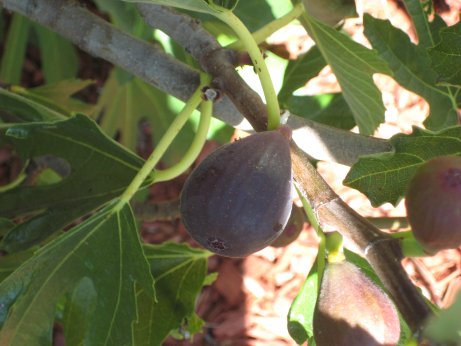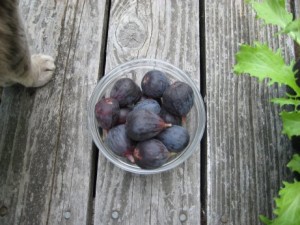In our neighborhood here in northern California, there are many places where we can forage wild blackberries from late summer into fall. When I go out to harvest wild blackberries I am reminded to be mindful of the thorns that these plants have on their stems and leaves. Blackberries are in the rose family, so it is not surprising to find thorns on these plants. Here is a nutrient analysis of one cup of blackberries (144 g):
| Blackberries – 1 cup | Adult Daily Requirements | |
| Calories | 62 | varies |
| Calcium | 42 | 1000 mg, 1200 mg |
| Iron | 0.9 | 8 mg for men and postmenopausal women, 18 mg for premenopausal women |
| Magnesium | 29 | 310 – 320 mg for women, 400 – 420 mg for men |
| Potassium | 233 | 4,700 mg |
| Zinc | 0.8 | 8 mg for women, 11 mg for men |
In reality, I eat more than one cup of blackberries in one sitting, so here is a nutrient analysis of 3½ cups of blackberries (504 g):
| Blackberries – 3½ cups | Adult Daily Requirements | |
| Calories | 217 | varies |
| Calcium | 246 | 1000 mg, 1200 mg |
| Iron | 3.1 | 8 mg for men and postmenopausal women, 18 mg for premenopausal women |
| Magnesium | 101 | 310 – 320 mg for women, 400 – 420 mg for men |
| Potassium | 816 | 4,700 mg |
| Zinc | 2.7 | 8 mg for women, 11 mg for men |
Often, people in the raw food community ask me if fruits are good source of minerals. The answer is that it depends on the fruit and how much one is eating of that fruit. As we can see, blackberries eaten in quantity can be a significant source of the minerals stated in the table above.
Not only can blackberries be a good source of certain important minerals, they are also well known for being a good source of antioxidants. Antioxidants are molecules that can neutralize free radicals before they cause damage to our cells.
A 2006 study measured the antioxidant content of over 1,000 foods and listed the 50 with the highest antioxidant content per 100 grams. Blackberries are number 19 on the list with 3.99 mmol antioxidants per 100 g. Foods that were higher than blackberries include ground cloves, oregano, ginger, cinnamon, turmeric, walnuts, basil, and others. For a full list please watch the video associated with this blog post or view the study listed in the reference section.
There is a challenge with measuring the antioxidant content of foods per 100 grams, given that one must consider how much of these foods one would actually eat in one sitting. Does it make sense that someone is going to eat 100 grams of cloves in one sitting? No, usually when one adds cloves to a recipe, the amount is usually around 1 teaspoon (2.1 grams) or a similar amount. However, it does make sense that one would eat 100 grams of blackberries (a little less than ¾ cup) or much more as mentioned earlier. When antioxidant content was measured per serving size, blackberries topped the list at 5.75 mmol antioxidants per cup, followed by walnuts, strawberries, artichokes, cranberries, and others. Ground cloves were further down on the list at number 10 with 2.64 mmol of antioxidants per teaspoon. Per serving, blackberries had the highest in antioxidants per serving than all other foods tested, which would include other high antioxidant berries like blueberries and raspberries.
What are some of the antioxidants found in blackberries? One type is anthocyanins, which are famous for their blue coloring. Other examples of anthocyanin containing foods include blueberries and raspberries.
Here is a video explaining this information with some added facts on the nutrient content of figs:
References:
Halvorsen BL, Carlsen MH, Phillips KM, Bøhn SK, Holte K, Jacobs DR Jr, Blomhoff R. Content of redox-active compounds (ie, antioxidants) in foods consumed in the United States. Am J Clin Nutr. 2006 Jul;84(1):95-135.
Nutrient content of blackberries: USDA nutrient database
But isn’t fruit controversial for some reason?
To make it easy for people to find reliable information on fruit, the glycemic index, glycemic load, fructose, glucose, and carbohydrates in general, we dedicated a chapter in our book, The Raw Food Nutrition Handbook: An Essential Guide to Understanding Raw Food Diets to answering many common carbohydrate questions.
In the book we also cover other hot topics in raw food nutrition such as essential fats, protein, nutrient content of raw food diets, food combining, enzymes, hydration, vitamins, minerals, and many more. We value education on these important topics and are happy to finally bring this book to you. The book is available on Amazon and other online booksellers.
One of the best ways to keep in touch with us is to join our email list. You’ll receive a free copy of Our Top 12 Strategies for Long Term Success on A Raw Plant-Based Diet eBook along with regular information about raw food and plant-based diets and periodic promotions for our classes, events, and other offerings!
Early October Figs
I love October. There are so many things to love about this beautiful month, such as the fall foliage, crispness of the air, leaf piles (dare I jump in? :)), pumpkins, the availability of certain fresh foods that are challenging to find at other times of the year, and the list goes on. One of the foods available now in northern California is fresh figs, such as those ripening on a tree in our front yard.
Before I moved to California, I thought of figs as strange looking dried fruits found in a bulk bin at my local health food store. When I first tried fresh figs, I found that the flavor and texture were quite different from the dried version. I do enjoy dried figs, and eat them from time to time, but I really enjoy fresh figs. People have asked me if I have any good fresh fig recipes – sorry, I do not. The reason why is because figs tend to disappear rather quickly in my house. 🙂
How long will these figs last in our house? Get out the stopwatch…..
The first time I saw a nutrient analysis of figs, I was amazed at the calcium and iron content, which is higher than most fruits per calorie. Potassium content is notable, too. Here are some nutrition highlights of figs:
| 6 medium figs (300 g) | Adult Daily Values | |
| Calories | 222 | |
| Calcium | 105 mg | 1000 – 1200 mg |
| Iron | 1.11 mg | 8 – 18 mg |
| Potassium | 696 mg | 4700 mg |
One of the best ways to keep in touch with us is to join our email list. You’ll receive a free copy of Our Top 12 Strategies for Long Term Success on A Raw Plant-Based Diet eBook along with regular information about raw food and plant-based diets and periodic promotions for our classes, events, and other offerings!



